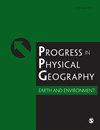在伊利诺斯州芝加哥市的城市河道中采用过度工作法评估河道不稳定的可能性:水力条件的空间变化与雨水缓解的相对重要性
IF 3.6
3区 地球科学
Q2 GEOGRAPHY, PHYSICAL
Progress in Physical Geography-Earth and Environment
Pub Date : 2024-09-04
DOI:10.1177/03091333241276205
引用次数: 0
摘要
城市环境中的雨水管理通常包括调节控制结构的蓄水释放率,以缓解可能造成破坏性洪水的峰值流量增大。这种缓解措施对河道地貌稳定性的影响程度在很大程度上仍未得到探讨。此外,很少有研究(如果有的话)探讨城市河道系统中的不稳定性与河道内结构的水力效应之间的关系。本文采用溪流动力建模方法,评估了伊利诺斯州库克县两条城市溪流在现有条件下河道不稳定的可能性。本文还评估了为缓解未来发展带来的洪水而设定的特定流域泄洪率对不稳定可能性的影响。该分析利用水文和水力模型来估算现有基本条件和四种释放率方案下 2 年和 50 年一遇暴雨事件的单位面积溪流功率。超过移动河床材料所需的临界功率的水流功率将随时间进行整合,以确定过量功。结果表明,在个别河段内,基本条件下的过量功的空间分布相差超过九个数量级,这证明河道不稳定的可能性很大。在两条溪流的特定河段内,相对于基础条件,释放率方案都会增加或减少超常功的大小,但不会大幅改变超常功的高变化性。研究结果表明,这些城市河川系统的不稳定性主要受水力特性空间变化的影响,而水力特性空间变化又与河道内多个结构物对河道的分割有关。本文章由计算机程序翻译,如有差异,请以英文原文为准。
An excess-work approach to assessing channel instability potential within urban streams of Chicago, Illinois: Relative importance of spatial variability in hydraulic conditions and stormwater mitigation
Stormwater management in urban environments typically involves regulation of release rates of stored water from control structures to mitigate enhanced peak flows that can cause damaging flooding. The extent to which this mitigation influences stream geomorphic stability remains largely unexplored. Moreover, few, if any, studies have examined how instability is related to hydraulic effects of in-channel structures within urban stream systems. This paper assesses the potential for channel instability under existing conditions in two urban streams in Cook County, Illinois using a stream-power modeling approach. It also evaluates the impact of watershed-specific release rates intended to mitigate flooding from future development on instability potential. The analysis utilizes hydrologic and hydraulic modeling to estimate stream power per unit area for 2-year and 50-year storm events for both the existing base condition and for four release-rate scenarios. Stream power exceeding the critical power required to mobilize channel bed material is integrated over time to determine excess work. Results show that the spatial distribution of excess work for the base condition varies by more than nine orders of magnitude within individual reaches, confirming high potential for instability. Release-rate scenarios both increase and decrease the magnitude of excess work relative to the base conditions within specific reaches of the two streams but do not alter substantially the high variability in excess work. The results demonstrate that instability potential in these urban fluvial systems is governed primarily by spatial variability in hydraulic properties associated with fragmentation of the streams by multiple in-channel structures.
求助全文
通过发布文献求助,成功后即可免费获取论文全文。
去求助
来源期刊
CiteScore
7.20
自引率
5.10%
发文量
53
审稿时长
>12 weeks
期刊介绍:
Progress in Physical Geography is a peer-reviewed, international journal, encompassing an interdisciplinary approach incorporating the latest developments and debates within Physical Geography and interrelated fields across the Earth, Biological and Ecological System Sciences.

 求助内容:
求助内容: 应助结果提醒方式:
应助结果提醒方式:


